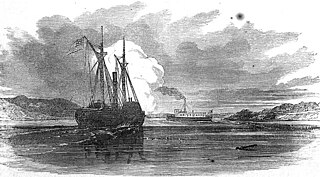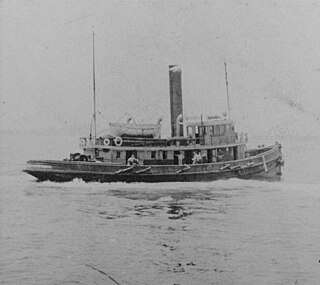
A tugboat or tug is a marine vessel that manoeuvres other vessels by pushing or pulling them, with direct contact or a tow line. These boats typically tug ships in circumstances where they cannot or should not move under their own power, such as in crowded harbors or narrow canals, or cannot move at all, such as barges, disabled ships, log rafts, or oil platforms. Some are ocean-going, and some are icebreakers or salvage tugs. Early models were powered by steam engines, which were later superseded by diesel engines. Many have deluge gun water jets, which help in firefighting, especially in harbours.

A fireboat or fire-float is a specialized watercraft with pumps and nozzles designed for fighting shoreline and shipboard fires. The first fireboats, dating to the late 18th century, were tugboats, retrofitted with firefighting equipment. Older designs derived from tugboats and modern fireboats more closely resembling seafaring ships can both be found in service today. Some departments would give their multi-purpose craft the title of "fireboat" also.

Eppleton Hall is a paddlewheel tugboat built in England in 1914. The only remaining intact example of a Tyne-built paddle tug, and one of only two surviving British-built paddle tugs, she is preserved at the San Francisco Maritime National Historical Park in San Francisco, California.

Lake freighters, or lakers, are bulk carrier vessels that operate on the Great Lakes of North America. These vessels are traditionally called boats, although classified as ships.

Empire Sandy is a tall ship providing chartered tours for the public from Toronto, Canada. She was built as an Englishman/ Larch Deep Sea-class tugboat for war service by the British government in 1943. After the end of World War II she was renamed Ashford and then Chris M before reverting to the original name of Empire Sandy and being converted to a schooner.

SS Foundation Franklin was a seagoing salvage tug built for the Royal Navy as HMS Frisky in 1918. In 1924, the tugboat was sold and renamed Gustavo Ipland before being acquired in 1930 by Foundation Maritime and renamed Foundation Franklin. The tugboat became famous for many daring salvage operations and rescues between 1930 and 1949. Her many rescues and salvage triumphs were celebrated in Farley Mowat's book The Grey Seas Under. In 1948, the ship was damaged in a hurricane and not considered repairable. The tug was broken up for scrap in 1949 at Halifax, Nova Scotia.

Theodore Too is a large-scale imitation tugboat built in Dayspring, Nova Scotia in 2000 based on the fictional television tugboat character Theodore Tugboat. Theodore Too was located in Bedford, Nova Scotia but arrived in Hamilton, Ontario, his new home, on July 18, 2021.
The Santa Fe Railroad tugboats were used by the Atchison, Topeka and Santa Fe Railway to barge rail cars across the San Francisco Bay for much of the 20th century, as there is no direct rail link to the San Francisco peninsula. In the post World War II period, a fleet of three tugs moved the barges: the Paul P. Hastings, the Edward J. Engel, and the John R. Hayden. After cross-bay float service had ended and the tugs had been sold, the Hastings sank off Point Arena, California in 1992, in water too deep to raise. The Engel sank off Alameda, California in 2007 and was raised and scrapped in the winter of 2013-14. The Hayden remains afloat and in service in Oregon.

Forceful is a sea-going tugboat built for the Queensland Tug Company by Alexander Stephen and Sons Ltd in Govan, Scotland in 1925. She worked at her homeport of Brisbane, Australia between 1926 and 1970 berthing ships and assisting nearby casualties. During World War II she was commissioned into the Royal Australian Navy in early 1942 as HMAS Forceful (W126), based at Fremantle and Darwin, until returning to commercial service in October 1943. She is preserved as a museum ship at Brisbane.

The Mackenzie River in Canada's Northwest Territories is a historic waterway, used for centuries by Indigenous peoples, specifically the Dene, as a travel and hunting corridor. Also known as the Deh Cho, it is part of a larger watershed that includes the Slave, Athabasca, and Peace rivers extending from northern Alberta. In the 1780s, Peter Pond, a trader with the North West Company became the first known European to visit this watershed and begin viable trade with the Athapascan-speaking Dene of these rivers. The Mackenzie River itself, the great waterway extending to the Arctic Ocean, was first put on European maps by Alexander Mackenzie in 1789, the Scottish trader who explored the river. The watershed thus became a vital part of the North American fur trade, and before the advent of the airplane or road networks, the river was the only communication link between northern trading posts and the south. Water travel increased in the late 19th century as traders, dominated primarily by the Hudson's Bay Company (HBC), looked to increase water services in the Mackenzie River District.

Marine Transportation Services (MTS) formerly Northern Transportation Company Limited (NTCL) is a marine transportation company operating primarily in the Mackenzie River watershed of the Northwest Territories and northern Alberta, and the Arctic Ocean using a fleet of diesel tug boats and shallow-draft barges. NTCL filed for bankruptcy in 2016 and its assets were acquired by the Government of the Northwest Territories later that year.

Bouker No. 2, originally Robert Rogers, was a tugboat built in 1904 for merchant service in and around the waters of New York City. During World War I, the tug was commissioned into the United States Navy as USS Bouker No. 2 (SP-1275), and continued in naval service until 1921. Briefly considered for service as a fireboat in Norfolk, Virginia, she was instead returned to merchant service in 1922 as a tugboat, under the name New York Marine Co. No. 6. She was sunk in collision with a passenger steamer in 1926.

Mayflower is a steam tug built in Bristol in 1861 and now preserved by Bristol Museums Galleries & Archives. She is based in Bristol Harbour at M Shed. She is the oldest Bristol-built ship afloat, and is believed to be the oldest surviving tug in the world.

The Type L6 ship is a United States Maritime Administration (MARAD) designation for World War II as a Great Lakes dry break bulk cargo ship. The L-Type Great Lakes Dry Bulk Cargo Ships were built in 1943 to carry much-needed iron ore from the upper Great Lakes to the steel and iron production facilities on Lakes Erie and Ontario in support of the war effort. The ships have a 15,675 tonne deadweight tonnage. The L6 ships were built by two companies: American Ship Building Company, in the case of the type L6-S-A1 models, of which 6 were built; and Great Lakes Engineering Works, Ashtabula, Ohio/ Great Lakes Engineering Works, River Rouge, Ohio, in the case of the type L6-S-B1, which produced 10 ships. Steel supply needed for World War was great. To supply iron ore from Lake Superior to steel foundries, the United States Commission had a series of L6 Lakers ship built. The Maritime Commission ordered ten Great Lakes Bulk Carriers of the L6-S-B1 type. The L6-S-B1 was design with a 3-cylinder triple expansion steam engines. The L6-S-A1 used a lentz 4-cylinder compound engine. All L6 ships were coal burning and delivered between May and November 1943. L6-S-B1 was built for the US Maritime Commission under USMC contract MCc-1834 in 1943 at the River Rouge yard. Each L6 ship cost $2.265 million. The first L6-S-B1 was the SS Adirondack/Richard J. Reiss, hull 290, keel was laid on March 9, 1942 and launched on September 19, 1942. The ships are often called the Class Lake Bulk Freighter now.

The Type V ship is a United States Maritime Commission (MARCOM) designation for World War II tugboats. Type V was used in World War II, Korean War, and the Vietnam War. Type V ships were used to move ships and barges. Type V tugboats were made of either steel or wood hulls. There were four types of tugboats ordered for World War II. The largest type V design was the sea worthy 186-foot (57 m) long steel hull, V4-M-A1. The V4-M-A1 design was used by a number of manufacturers; a total of 49 were built. A smaller steel hull tugboat was the 94-foot (29 m) V2-ME-A1; 26 were built. The largest wooden hull was the 148-foot (45 m) V3-S-AH2, of which 14 were built. The smaller wooden hull was the 58-foot (18 m) V2-M-AL1, which 35 were built. Most V2-M-AL1 tugboats were sent to the United Kingdom for the war efforts under the lend-lease act. The Type V tugs served across the globe during World War II including: Pacific War, European theatre, and in the United States. SS Farallon, and other Type V tugs, were used to help built Normandy ports, including Mulberry harbour, on D-Day, 6 June 1944, and made nine round trips to Normandy to deliver Phoenix breakwaters.

The Ramparts are rapids in a 12-kilometre (7.5 mi) canyon that forms a navigational impediment on Canada's Mackenzie River, in the Northwest Territories. The river narrows from almost 2 kilometres (6,600 ft) wide to barely more than 100 metres (330 ft).

Henry Christoffersen is a shallow draft pusher tug built to operate on Canada's Mackenzie River. She was launched in 1973, and was the name ship of her class. She was designed by the Robert Allan Ltd. ship architects. She was built in Esquimalt, BC at a shipyard known as Burrard Yarrows.

Radium Franklin was a tugboat built in 1951, and operated by the Northern Transportation Company - popularly known as the "Radium Line", because many of their tugboats contained Radium in their name, since they were originally built to haul Uranium ore from Port Radium, on Great Bear Lake. She was retired in 1979, after spending most of her career hauling barge packed with ore, and then briefly serving as a yard tug.
The Yellowknife Expeditor was a small freighter that operated in Canada's Arctic. She was built for the United States Navy, during World War II, as a shallow draft Landing Craft Infantry, displacing approximately 250 tons. She was acquired by the Yellowknife Transportation Company, who had her converted to carry passengers and freight at the Victoria Machinery Depot, in 1949.

















